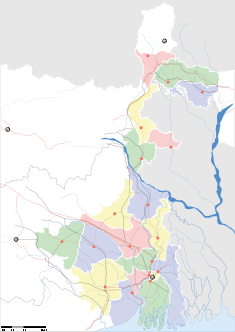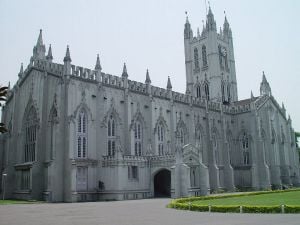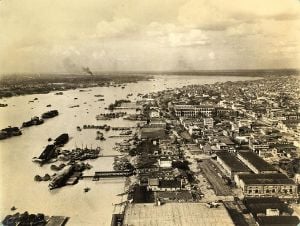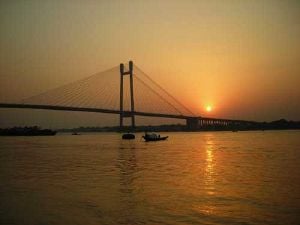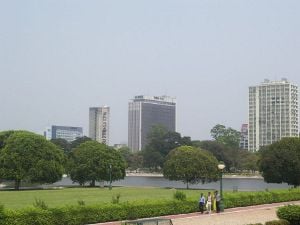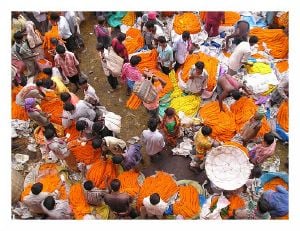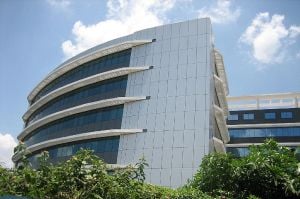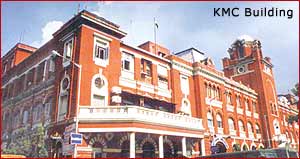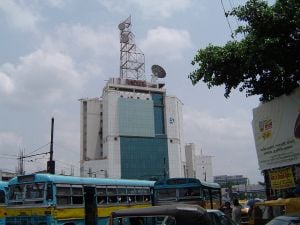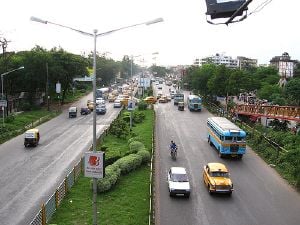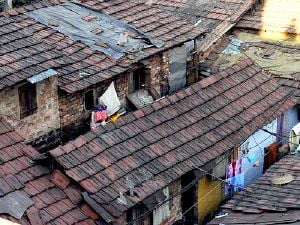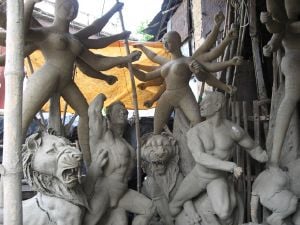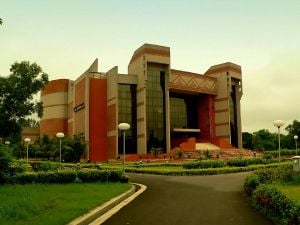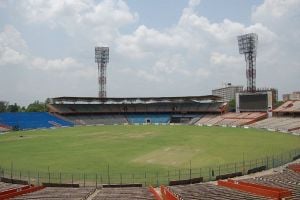Kolkata
| Kolkata (কলকাতা) West Bengal • India | |
| Nickname: City of Joy | |
| Coordinates: | |
| Time zone | IST (UTC+5:30) |
| Area • Elevation |
185 km² (71 sq mi) • 9 m (30 ft) |
| District(s) | Kolkata † |
| Population • Density • Metro |
4,486,679[1] (7th) (2011) • 24,252 /km² (62,812 /sq mi) • 14,112,536[2] (3rd) (2011) |
| Mayor | Sovan Chatterjee |
| Codes • Pincode • Telephone • UN/LOCODE • Vehicle |
• 700 001 - 700 157 • +91 (0)33 • INCCU • WB-01 to WB-04 |
| Website: www.kolkatamycity.com | |
| † The Kolkata urban agglomeration also includes portions of North 24 Parganas, South 24 Parganas, Howrah, Nadia, and Hooghly districts. | |
Coordinates:
Kolkata (Bengali: কলকাতা, IPA: 'kolkat̪a]), formerly Calcutta, is the capital of the Indian state of West Bengal. It is located in eastern India on the east bank of the River Hooghly. The city has a population of almost 4.5 million, with an extended metropolitan population of over 14 million, making it the third-largest urban agglomeration and the fourth-largest city in India. Like other large cities, Kolkata continues to struggle with problems of urbanization such as poverty, pollution, and traffic congestion.
Kolkata served as the capital of India during the British Raj until 1911. Once the center of modern education, science, culture and politics in India, Kolkata witnessed economic stagnation in the years following India's independence in 1947. However, since the year 2000, an economic rejuvenation has arrested the decline and led to a spurt in the city's growth. Kolkata is noted for its revolutionary history, ranging from the Indian struggle for independence to the leftist and trade union movements. This vibrant city, with a distinct socio-political culture, is considered by many as the cultural capital of India.
| This article contains Indic text. Without proper rendering support, you may see question marks or boxes, misplaced vowels or missing conjuncts instead of Indic text. |
Name
The names Kolkata and Calcutta were probably based on Kalikata, the name of one of the three villages (Kalikata, Sutanuti, Gobindapur) in the area before the arrival of the British.[3] "Kalikata," in turn, is believed to be an anglicized version of Kalikshetra ("Land of [the goddess] Kali"). The place was known for the manufacture of shell-lime; the name may have been derived from lime (kali) and burnt shell (kata). Alternatively, the name may have been derived from the Bengali term kilkila ("flat area")[4], or the name may have its origin in the indigenous term for a natural canal, Khal, followed by Katta (which may mean dug).[5] While the city was always pronounced either "Kolkata" or "Kolikata" in the local Bengali language, its official English name was only changed from "Calcutta" to "Kolkata" in 2001, to reflect the Bengali pronunciation. Some view this as a move to erase the legacy of British rule.[6]
History
The discovery of the nearby Chandraketugarh,[7] an archaeological site, provides evidence that the area has been inhabited for over two millennia.[8] The city's documented history, however, begins with the arrival of the British East India Company in 1690, when the Company was consolidating its trade business in Bengal. Job Charnock, an administrator with the Company who eventually settled in Sutanuti after invading through Hijli Kingdom, was traditionally credited as the founder of the city; however, recently experts have endorsed the view that Charnock was not the founder of the city.[9]
In 1698, the East India Company bought three villages (Sutanuti, Kalikata and Gobindapur) from a local landlord family of Sabarna Roy Choudhury. The next year, the company began developing the city as a Presidency City. In 1699, the British completed the construction of old Fort William, which was used as a place to station its troops and as a regional base. Kolkata (then Calcutta) was declared a Presidency City, and later became the headquarters of the Bengal Presidency. In 1727, by the order of King George I, a civil court was set up in the city. The Calcutta Municipal corporation (recently renamed as Kolkata Municipal Corporation) was formed and the city had its first mayor.
Early in 1756, faced with frequent skirmishes with French East India Company forces, the British authorities in Calcutta began repairs to the fortifications of old Fort William, which were extremely decayed. This irritated the new Nawab of Bengal, Siraj Ud Daulah, who viewed it as a threat to his sovereignty. When his protests went unheeded, Siraj ud-Daula first attacked and captured Cossimbazar, and then Calcutta, which fell after a short siege on June 20, 1756, during which the Governor and many other officials escaped down the Hooghly River, leaving the remainder of the garrison and the Eurasian population of Calcutta to their fate. This is now known as the Siege of Calcutta. It was reported that after his victory, 123 Britons died in a small, suffocating prison called the “Black Hole of Calcutta,” but recent evidence calls into question the numbers involved, and suggests that the Nawab himself was probably unaware of what transpired. He renamed Calcutta “Alinagar” after the previous Nawab, and his maternal grandfather, Alivardi Khan. Having installed Manikchand as the ruler of Alinagar, Siraj returned to Murshidabad. On January 2, 1757, Admiral Watson and Robert Clive retook Calcutta with a force of Company sepoys and the assistance of the Royal Navy. Hearing the news, Siraj ud-Daula moved to attack Calcutta, but fearing an attack from Ahmad Shah Abdali, after a few days of war he signed the Treaty of Alinagar with the British East India Company, giving them permission to build the fort.
Kolkata was named the capital of British India in 1772, although the capital shifted to the hilly town of Shimla during the summer months every year, starting from the year 1864.[10] It was during this period that the marshes surrounding the city were drained and the government area was laid out along the banks of the Hooghly River. Richard Wellesley, the Governor General between 1797 – 1805, was largely responsible for the growth of the city and its public architecture, which led to the description of Kolkata as "The City of Palaces." The city was a center of the British East India Company's opium trade during the eighteenth and nineteenth centuries; locally produced opium was sold at auction in Kolkata, to be shipped to China.
By the early nineteenth century, Kolkata was split into two distinct areas—one British (known as the White Town), the other Indian (known as Black Town).[11] Even at the time, the poverty of the 'Black Town' shanties was considered shocking. The city underwent rapid industrial growth from the 1850s, especially in the textile and jute sectors; this resulted in massive investment by the British government in infrastructure projects like rail roads and telegraph lines. The coalescence of British and Indian culture resulted in the emergence of a new Babu class of urbane Indians—whose members were often bureaucrats, professionals, read newspapers, were Anglophiles, and usually belonged to upper-caste Hindu communities.[12] Throughout the nineteenth century, a socio-cultural reform, often referred to as the Bengal Renaissance resulted in the general uplifting of the people.
In 1883, Surendranath Banerjea organized an Indian national conference, the first of its kind in nineteenth century India. This conference heralded the birth of the Indian National Congress. The first native president of the Indian National Congress Sir Womesh Chunder Bonnerjee and the first Congress president to advocate self rule by Indians, Sir Surendra Nath Banerjea (referred to by the British as "Surrender Not") were early eminent Calcuttans, who influenced nationalist thinking in the late nineteenth and early twentieth centuries. The estimated population of Calcutta in 1900 had grown to close to one million. Gradually Kolkata became a center of the Indian independence movement, and especially of revolutionary organizations. The 1905 Partition of Bengal on communal grounds resulted in widespread public agitation and the boycott of British goods (Swadeshi movement).
These activities, along with the administratively disadvantageous location of Kolkata in the eastern fringes of India, prompted the British to relocate the capital to New Delhi in 1911.
The city's port was bombed twice by the Japanese during World War II.[13] In 1946, demands for the creation of a Muslim state led to large-scale communal violence resulting in the deaths of over 2000 people.[14] The partition of India also created intense violence and a shift in demographics - large numbers of Muslims left for East Pakistan, while hundreds of thousands of Hindus fled into the city.[15]
Over the 1960s and 1970s, severe power shortages, strikes and a violent Marxist-Maoist movement, the Naxalites, damaged much of the city's infrastructure, leading to an economic stagnation. In 1971, war between India and Pakistan led to the mass influx of thousands of refugees into Kolkata, placing a massive strain on its infrastructure.[16] In the mid-1980s, Mumbai overtook Kolkata as India's most populous city. Kolkata has been a strong base of Indian communism as West Bengal has been ruled by the CPI(M) dominated Left Front for three decades now, the world's longest-running democratically-elected Communist government.[17][18] The city's economic recovery gathered momentum after [[economic reforms introduced by the central Indian government in the mid-1990s. Since 2000, Information Technology (IT) services have revitalized the city’s stagnant economy. The city is also experiencing growth in the manufacturing sector.
Geography
Kolkata is located in eastern India at 22°33′N 88°20′E in the Ganges Delta at an elevation ranging between 1.5 to 9 metres.[19] It is spread linearly along the banks of the River Hooghly in a north-south direction. Much of the city was originally a vast wetland, reclaimed over the decades to accommodate the city's burgeoning population.[20] The remaining wetland, known as East Calcutta Wetlands has been designated a "wetland of international importance" under the Ramsar Convention.
Like the most of the Indo-Gangetic plains, the predominant soil type is alluvial. Quaternary sediments consisting of clay, silt, various grades of sand and gravel underlie the city. These sediments are sandwiched between two clay beds, the lower one at depths between 250 and 650 m and the upper one ranging between 10 and 40 m in thickness.[21] According to the Bureau of Indian Standards, the town falls under seismic zone-III, in a scale of I to V (in order of increasing proneness to earthquakes)[22] while the wind and cyclone zoning is "very high damage risk," according to a report by the United Nations Development Programme.[22]
Climate
Kolkata has a tropical climate. The annual mean temperature is 26.8 °C (80 °F); monthly mean temperatures range from 19 °C to 30 °C (67 °F to 86 °F).[23] Summers are hot and humid and maximum temperatures often exceed 40 °C (104 °F) during May and June.[23] Winter tends to last for only about two and a half months, with seasonal lows dipping to 12 °C – 14 °C (54 °F – 57 °F) between December and January. The highest recorded temperature is 43.9 °C (113 °F) and the lowest is 5 °C (41 °F).[23] Often during early summer, dusty squalls followed by spells of thunderstorm and heavy rains lash the city, bringing relief from the humid heat. These thunderstorms are convective in nature, and are locally known as Kal baisakhi (Nor'westers). Rains brought by the Bay of Bengal branch of South-West monsoon[24] lash the city between June and September and supplies the city with most of its annual rainfall of 1,582 mm. The highest rainfall occurs during the monsoon in August (306 mm). The city receives 2,528 hours of sunshine per annum, with the maximum sunlight occurring in March.[25] Pollution is a major concern in Kolkata, and the Suspended Particulate Matter (SPM) level is high when compared to other major cities of India,[26][27] leading to regular smog and haze. Severe air pollution in the city has caused rise in pollution-related respiratory ailments such as lung cancer.[28]
Urban Structure
Kolkata city, under the jurisdiction of the Kolkata Municipal Corporation (KMC), has an area of 185 km². The Kolkata urban agglomeration, however, has continuously expanded and as of 2006, the urban agglomeration (Kolkata Metropolitan Area) is spread over 1750 km² and comprises 157 postal areas. The urban agglomeration is formally administered by several local governments including 38 local municipalities. The urban agglomeration comprises 72 cities and 527 towns and villages.[29] The suburban areas of Kolkata metropolitan district incorporates parts of the districts North 24 Parganas, South 24 Parganas, Howrah, Hooghly and Nadia.
The east-to-west dimension of the city proper is narrow, stretching from the Hooghly River in the west to roughly the Eastern Metropolitan Bypass in the east, a span of barely 5–6 km.[30] The north-south expansion is roughly divided into North, Central and South Kolkata. North Kolkata locality is the oldest part of the city, with nineteenth century architecture and narrow alleyways. The ambiance in this area is reminiscent of the old Kolkata. South Kolkata grew mostly after independence and consists of elite localities. The Salt Lake City (Bidhan Nagar) area to the northeast of the city is a planned section of Kolkata. Rajarhat, also called New Town, is a planned township being developed on the north-eastern fringes of the city.
Central Kolkata houses the central business district around the B. B. D. Bagh area. The government secretariat, General Post Office, High Court, Lalbazar Police HQs and several other government and private offices are located here. The Maidan is a large open field in the heart of the city where several sporting events and public meetings are held. Several companies have set up their offices around the area south of Park Street which has become a secondary Central Business District.
Economy
Kolkata is the main business, commercial and financial hub of eastern India and the northeastern states. It is home to the Calcutta Stock Exchange—India's second-largest bourse.[31] It is also a major commercial and military port, and the only city in the region to have an international airport. Once India's leading city and capital, Kolkata experienced a steady economic decline in the years following India's independence due to the unstable political situation and a rise in trade-unionism supported by left-wing parties. From the 1960s to the mid 1990s, flight of capital was enormous as many large factories were closed or downsized and businesses relocated. The lack of capital and resources coupled with a worldwide glut in the market for the city's traditional industries (such as jute) added to the depressed state of the city's economy.[32] The liberalization of the Indian economy in the 1990s along with the election of a new reformist Chief Minister, Buddhadeb Bhattacharya have resulted in the improvement of the city's fortunes.
Until recently, flexible production had always been the norm in Kolkata, and the informal sector has comprised more than 40% of the labor force.[33] State and federal government employees make up a large percentage of the city's workforce. The city has a large unskilled and semi-skilled labor population, along with other blue-collar and knowledge workers. Kolkata's economic revival was led largely by IT services, with the IT sector growing at 70 per cent yearly—twice that of the national average.[34] In recent years there has been a surge of investment in the housing infrastructure sector, with several new projects coming up in the city.[35] Kolkata is home to many industrial units operated by large Indian corporations with products ranging from electronics to jute. Some notable companies headquartered in Kolkata include ITC Limited, Bata India, Birla Corporation, Coal India Limited, Damodar Valley Corporation, United Bank of India, UCO Bank and Allahabad Bank Vijaya Bank. Recently, various events such as the adoption of a "Look East" policy by the government of India, the opening of the Nathu La Pass in Sikkim as a border trade-route with China, and increased interest among the South East Asian countries in investing in the Indian market and invest have put Kolkata in an advantageous position.
Civic Administration
The Kolkata Municipal Corporation (KMC), (formerly the Calcutta Municipal Corporation), established in 1876, is responsible for the civic maintenance and infrastructure of Kolkata. The city is divided into 141 administrative wards that are grouped into 15 boroughs. Each of these wards elects a councilor to the KMC. Each borough has a committee consisting of the councilors elected from the respective wards of the borough. The Corporation, through the borough committees, maintains government-aided schools, hospitals and municipal markets and partakes in urban planning and road maintenance.[29] The corporation as the apex body discharges its function through the Mayor-in-Council, consisting of a mayor, assisted by a deputy mayor, and ten other elected members of the KMC. The mayor is responsible for the overall functioning of the KMC and has a tenure of five-years.[36] At present, the CPI(M) led Left Front holds the power in KMC.
The city also has an apolitical titular post, that of the Sheriff of Kolkata. The Sheriff presides over various city-related functions and conferences. Another ancillary civic body is the Kolkata Metropolitan Development Authority (KMDA) responsible for the statutory planning and development of the Kolkata Metropolitan Area (KMA). The KMA includes a large suburban hinterland around the urban centers of Kolkata.
As the capital of the state and the seat of the Government of West Bengal, Kolkata houses the West Bengal Legislative Assembly, the Secretariat (Writers' Building) and the Calcutta High Court. Kolkata also has lower courts; the Small Causes Court for civil matters, and the Sessions Court for criminal cases. The Kolkata Police, headed by the Police Commissioner, comes under the West Bengal Home Ministry. The city is administratively divided into five police-zones subdivided into 48 local police stations. The city elects 3 representatives to the Lok Sabha (India's lower house) and 21 representatives to the state Legislative Assembly.[37]
Utility Services and Media
The KMC supplies potable water to the city, drawn from the River Hooghly and purified and treated at Palta water pumping station located in North 24 Parganas. Almost all of Kolkata's daily refuse of 2500 tonnes is transported to the dumping grounds in Dhapa to the east of the town. Agriculture is encouraged on this dumping ground for natural recycling of garbage and sewer water.[38] Parts of the city still lack sewage facilities leading to unsanitary methods of waste disposal.[25]Electricity is supplied by the privately operated Calcutta Electric Supply Corporation (CESC) to the city region, and by the West Bengal State Electricity Board in the suburbs. Frequent interruption of power supply was a problem until the mid 1990s; however the situation has since improved immensely with seldom power cuts occurring presently. The city has 20 fire stations (under West Bengal Fire Service) that attend to 7,500 fire and rescue calls on average per year.[39]
State-owned BSNL and private enterprises like Hutch, Airtel, Reliance Infocomm and Tata Indicom are the leading telephone and cell phone service providers in the city. Cellular coverage is extensive with both GSM and CDMA services being available. Broadband internet penetration has steadily increased with BSNL, Tata Indicom, Airtel and Reliance being the leading service providers.
Bengali language newspapers like Anandabazar Patrika, Aajkaal, Bartaman, Sangbad Pratidin and Ganashakti are widely circulated. Regional and national English newspapers such as The Telegraph, The Statesman, Asian Age, Hindustan Times and The Times of India are sold in large numbers. Some major periodicals are Desh, Sananda, Unish Kuri, Anandalok and Anandamela. As the biggest trading market in Eastern India, Kolkata has a substantial readership of many financial dailies including Economic Times & Business Standard. Vernacular newspapers such as those in Hindi, Gujarati, Oriya, Urdu, Punjabi and Chinese are also read by a minority. Kolkata has nine local FM stations: AIR Kolkata (FM Rainbow & FM Gold), Radio Mirchi (98.3 MHz), Red FM (93.5 MHz), Aamar FM (106.2 MHz), Gyan Vani (105.4 MHz), Big FM (92.7 MHz), Power FM (107.8 MHz) and Friends FM (91.9 MHz). The state-owned television broadcaster Doordarshan provides two free terrestrial channels, while four MSO provide a mix of Bengali, Hindi, English and other regional channels via cable.
Transport
Public transport is provided by the Kolkata suburban railway and the Kolkata Metro as well as by trams and buses. The suburban network is extensive and extends into the distant suburbs. The Kolkata Metro, run by the Indian Railways, is the oldest underground system in India. It runs parallel to the Hooghly and spans the north-south length of the city covering a distance of 16.45 km (10.22 miles). Buses are the preferred mode of transport and are run by both government agencies and private operators. Kolkata is India's only remaining city to have a tram network, operated by Calcutta Tramways Company. The slow-moving tram services are restricted to certain areas of the city. Water-logging due to heavy rains during the monsoon sometimes interrupts the public transport.[40][41]
Hired forms of mechanized transport include the yellow metered taxis, and auto rickshaws which ply specific routes. In some areas of the city, cycle rickshaws and hand-pulled rickshaws are also patronized by the public for short distances. Privately owned vehicles are fewer in number compared to other major Indian cities, due to the abundance and availability of a variety of public vehicles. However, the city witnessed a steady increase in the number of registered vehicles; 2002 data showed an increase of 44 percent over a period of seven years.[42] The road space (matched with population density) in the city is only 6 percent, compared to 23 percent in Delhi and 17 percent in Mumbai, creating major traffic problems.[43] Kolkata Metro Railway and a number of new roads and flyovers have decongested the traffic to some extent.
Kolkata has two major long distance railway stations, Howrah Station and Sealdah. A third station, named Kolkata, was launched in 2006. The city is the headquarters of two divisions of the Indian Railways—Eastern Railway and South Eastern Railway.
The city's sole airport, the Netaji Subhash Chandra Bose International Airport at Dum Dum to the north of the city, operates both domestic and international flights. Kolkata is also a major riverport for eastern India. The Kolkata Port Trust manages both the Kolkata docks and the Haldia docks.[44] There is passenger service to Port Blair in the Andaman and Nicobar Islands and cargo ship service to various ports in India and abroad, operated by the Shipping Corporation of India. Ferry services connect Kolkata with its twin city of Howrah.
Demographics
Residents of Kolkata are called Calcuttans. As of 2001, Kolkata city had a population of 4,580,544, and the urban agglomeration had a population of 13,216,546. The sex ratio is 828 females per 1000 males[45] – which is lower than the national average, because many working males come from rural areas and leave their families behind. Kolkata's literacy rate of 80.86 percent[46] exceeds the all-India average of 64.8 percent.[47] Kolkata Municipal Corporation area has registered a growth rate of 4.1 percent, which is the lowest among the cities in India with a population of more than one million.[48]
Bengalis comprise the majority of Kolkata's population, with Marwaris and Bihari communities forming a large portion of the minorities. Some of Kolkata's notable communities include Chinese, Tamils, Marwaris, Gujaratis, Anglo-Indians, Armenians, Tibetans, Maharashtrians and Parsis. Major languages spoken in Kolkata are Bengali, Hindi, Urdu, English, Maithili, and Bhojpuri.
According to the 2001 census, 77.68 percent of the population in Kolkata is Hindu, 20.27 percent Muslim,0.88 percent Christian and 0.75 percent Jains. Other minorities such as Sikhs, Buddhists, Jews and Zoroastrians constitute the rest of the city's population.[49]More than 1.5 million people, who constitute about a third of the city's population, live in 2,011 registered and 3,500 unregistered (occupied by squatters) slums.[50]
Kolkata reported 67.6 percent of total Special and Local Laws (SLL) crimes registered in 35 Indian mega cities.[51] Kolkata police district registered 10,757 Indian Penal Code cases in 2004, which was tenth highest rate in the country.[52] The crime rate in the city was 81.4 per 100,000 against the national rate of 168.8 in 2004.[53] Kolkata's Sonagachi area, with more than 10,000 sex workers,[54] is one of Asia's largest red-light districts.
Culture
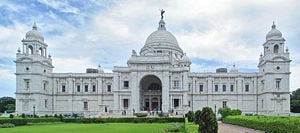
Kolkata is sometimes referred to as the “City of Joy.” Kolkata has long been known for its literary, artistic and revolutionary heritage. As the former capital of India, Kolkata was the birthplace of modern Indian literary and artistic thought. Kolkatans tend to have a special appreciation for art and literature; its tradition of welcoming new talent has made it a "city of furious creative energy."[55] A person from Calcutta is known variously as a Calcuttan or Kolkatan.
A characteristic feature of Kolkata is the strong sense of community of the para (neighborhoods). Typically, every para has its own community club with a clubroom and often, a playing field, where the occupants habitually indulge in adda (leisurely chats), often a form of freestyle intellectual conversation. The city has a tradition of political graffiti depicting everything from outrageous slander to witty banter and limericks, caricatures to propaganda.
The city has a tradition of drama in the form of jatra (a kind of folk-theater), theaters and Group Theaters. Mainstream Hindi films (Bollywood) are popular, as are films from the Bengali cinema industry, dubbed "Tollywood" for Tollygunj, the district in Kolkata where Bengali movie studios are located. Its long tradition of filmmaking includes acclaimed directors like Satyajit Ray, Mrinal Sen, Tapan Sinha and Ritwik Ghatak; and contemporary directors such as Aparna Sen and Rituparno Ghosh.
The city is also noted for its appreciation of Indian classical music and the rich literary tradition set by Bankim Chandra Chattopadhyay, Rabindranath Tagore, Jibanananda Das, Kazi Nazrul Islam, Sarat Chandra Chattopadhyay, Tarashankar Bandopadhyay, Samaresh Basu, Shirshendu Mukhopadhyay, Buddhadev Guha,Sanjeeb Chattopadhyay and Sunil Gangopadhyay. Since the early 1990s, there has been an emergence and popularization of new genres of music, including fusions of Baul and Jazz by several Bangla bands, as well as the emergence of what has been called Jeebonmukhi Gaan (a modern genre based on realism) by artists like Anjan Dutta, Nachiketa and bands like Chandrabindu, Cactus and Fossils.
Key elements of Kolkata's cuisine include rice and macher jhol (fish curry),[56] with rasagolla,sandesh and mishti doi (sweet yoghurt) as dessert. Bengal's vast repertoire of fish-based dishes includes various hilsa preparations (a favorite among Bengalis). Street foods such as beguni (fried battered eggplant slices), kati roll (flatbread roll with vegetable or chicken, mutton, or egg stuffing), phuchka (deep fried crêpe with tamarind and lentil sauce) and Chinese food from China Town in the eastern parts of the city are quite popular.
Bengali women commonly wear the shaŗi and the salwar kameez, often distinctly designed according to local cultural customs. In Kolkata there is a growing trend among the youth girls and women to wear Western attire. Among men, European dressing has greater acceptance. Men also wear traditional costumes such as the panjabi with dhuti or pyjama, often on religious occasions.
Kolkata has many buildings adorned with Gothic, Baroque, Roman, Oriental and Indo-Islamic (including Mughal) motifs. The "City of Palaces," as Kolkata is often called, is dotted with colonial buildings. Some of the major buildings of this period are well maintained and several buildings have been declared "heritage structures," while others are in various stages of decay. Established in 1814, the Indian Museum is the oldest museum in Asia and houses vast collections of Indian natural history and Indian Art.[57] The Victoria Memorial, one of the major tourist attractions in Kolkata, has a museum documenting the city's history. The National Library of India is India's leading public library. Academy of Fine Arts and other art galleries hold regular art exhibitions.
Durga Puja is the most notable of the religious and social festival in Kolkata.[58] Other notable festivals include Diwali, Eid, Holi, Christmas, poila boishak (new year), Saraswati puja, Rath Yatra and Poush parbon (harvest festival). Some of the cultural festivals are Kolkata Book Fair, Dover Lane music festival, Kolkata Film Festival and National Theatre Festival. Kolkata is sister city to Long Beach, California in the United States.
Education
Kolkata's schools are either run by the state government or by private (many of which are religious) organizations. Schools mainly use English or Bengali as the medium of instruction, though Hindi and Urdu are also used. The schools are affiliated with the Indian Certificate of Secondary Education (ICSE), the Central Board for Secondary Education (CBSE), or the West Bengal Board of Secondary Education. Under the 10+2+3 plan, after completing their secondary education, students typically enroll in a two-year junior college (also known as a pre-university) or in schools with a higher secondary facility affiliated with West Bengal Council of Higher Secondary Education. Students usually choose from one of three streams—liberal arts, commerce, or science, though vocational streams are also available. Upon completing the required coursework, students may enroll in general or professional degree programs.
Kolkata has nine universities; numerous colleges are affiliated to these nine or to other universities located outside of Kolkata.[59] The University of Calcutta (founded in 1857) has more than 200 affiliated colleges.[60] Bengal Engineering & Science University, West Bengal University of Technology and Jadavpur University are notable engineering universities.[61] Other notable institutions are Presidency College and St. Xavier's College. Some institutions of national importance are the Asiatic Society, Bose Institute, the Indian Statistical Institute, the Indian Institute of Management, the Indian Association for the Cultivation of Science, the Saha Institute of Nuclear Physics, the West Bengal National University of Juridical Sciences, the Marine Engineering and Research Institute, the Indian Institute of Science Education and Research and the Indian Institute of Social Welfare and Business Management.
Sports
Football is the most popular sport in the city and the city is one of the major centers of football activity in India.[62] Kolkata is home to top national clubs such as Mohun Bagan, Mohammedan Sporting Club and East Bengal. As in the rest of India, cricket is popular and is played throughout the city in its grounds and streets. Tournaments, especially those involving outdoor games like cricket, football, and badminton or indoor games like carrom, are regularly organized on an inter-locality or inter-club basis. The maidan area hosts several minor football and cricket clubs and coaching institutes. Notable sports stars from Kolkata include former Indian national cricket captain Sourav Ganguly and Olympic tennis bronze medalist Leander Paes. Former football stars include Olympic medalist Shailen Manna, Chuni Goswami, Subrata Bhattacharya.
Kolkata is known for its large stadiums. The Eden Gardens is one of only two 100,000-seat cricket amphitheaters in the world. Salt Lake Stadium—a multi-use stadium—is the world's third highest-capacity football stadium. Calcutta Cricket and Football Club is the second-oldest cricket club in the world. Kolkata has three 18-hole golf courses at the Royal Calcutta Golf Club (the first golf club in the world outside Britain) Tollygunge Club and Fort William. The Royal Calcutta Turf Club (RCTC) holds regular equestrian races and polo matches. The Calcutta Polo Club is now considered as the oldest polo club in the world.[63] The Calcutta South Club is the venue for some national and international tennis tournaments. The Calcutta Rowing Club hosts regular rowing races and training.
Notes
- ↑ Census of India,Provisional Population Totals for Census 2011:West Bengal Censusindia.gov.in. Retrieved September 30, 2011.
- ↑ Census of India 2011, Provisional Population Totals. Retrieved May 11, 2012.
- ↑ SC Mukherjee. 1991. The changing face of Calcutta: An architectural approach. (Calcutta, 300, Government of West Bengal)
- ↑ Kolkata (Calcutta): History. Calcuttaweb.com. Bangla Retrieved February 18, 2007.
- ↑ P. Thankappan Nair. Calcutta in the 17th Century. (Firma KLM Private Limited, 1986)
- ↑ Kenny Easwaran, The Politics of Name Changes in India. OCF, UC Berkeley. Retrieved August 12, 2007.
- ↑ Chandraketugarh unfold Bengal’s rich heritage.India.merinews.Retrieved January 27, 2009.
- ↑ S. Das, Pre-Raj crown on Clive House - Abode of historical riches to be museum. The Telegraph, Calcutta, India, 2003-01-15. Retrieved April 26, 2006.
- ↑ Subhrangshu Gupta, Job Charnock not Kolkata founder: HC Says city has no foundation day. Nation The Tribune. May 18, 2003. Retrieved December 7, 2006.
- ↑ IANS Shimla - more than just Raj nostalgia Yahoo news August 7, 2007. Retrieved August 8, 2007.
- ↑ Pratapaditya Pal, Calcutta: Changing Visions, Lasting Images Through 300 Years (Bombay: Marg Publications, 1990, ISBN 8185026114), 31–46.
- ↑ Nirad C. Chaudhuri, The Autobiography of an Unknown Indian (New York, NY: New York Review of Books, 2001, ISBN 094032282X).
- ↑ K. Randhawa, The bombing of Calcutta by the Japanese. BBC.
- ↑ H. S. Suhrawardy, Memoirs of Huseyn Shaheed Suhrawardy.. Direct Action Day'. MHR Talukdar, (ed.) (University Press of Bangladesh,1987, ISBN 9840510878), 55–56. Retrieved January 27, 2009.
- ↑ R. Gandhi. 1991. Patel: A Life. (New Delhi: Navajivan Publishing House.), 497
- ↑ Jane Hindle, (ed.), London Review of Books: An Anthology (London: Verso, 1996, ISBN 185984121X), 63–70.
- ↑ S. Biswas, Calcutta's colorless campaign. BBC News. Retrieved April 26, 2006.
- ↑ Ananya Roy and Nezar AlSayyad (eds.), Urban Informality: Transnational Perspectives from the Middle East, Latin America and South Asia (Lexington Books, 2004, ISBN 0739107410).
- ↑ NASA image, Photojournal. Retrieved November 21, 2007.
- ↑ An Introduction, History of Calcutta, Catchcal.com Retrieved August 29, 2007
- ↑ SW. Bunting, N. Kundu, M. Mukherjee, Situation Analysis. Production Systems and Natural Resources Use in PU Kolkata, Institute of Aquaculture, University of Stirling, Stirling, UK. Retrieved April 26, 2006.
- ↑ 22.0 22.1 Hazard profiles of Indian districts. National Capacity Building Project in Disaster Management Retrieved August 23, 2006.
- ↑ 23.0 23.1 23.2 Canty and Associates LLC, Weatherbase entry for Kolkata Retrieved April 26, 2006.
- ↑ M.L. Khichar and Ram Niwas, Know your monsoon Agriculture Tribune, The Tribune, July 14 2003. Retrieved June 9, 2007.
- ↑ 25.0 25.1 Calcutta: Not 'The City of Joy'. Gaia: Environmental Information System. Retrieved April 26, 2006.
- ↑ Central Pollution Control Board, Ambient Air Quality in Seven Major Cities During 2002, Ministry of Environment & Forests, Govt of India. Retrieved April 26, 2006.
- ↑ Central Pollution Control Board, Air quality in major cities on 16–17 March, 2006, Ministry of Environment & Forests, Govt of India. Retrieved April 26, 2006.
- ↑ Subir Bhaumik, Oxygen supplies for India police BBC, May 17, 2007. Retrieved June 23, 2007.
- ↑ 29.0 29.1 World Association of the Major Metropolises 007 Kolkata (India). Retrieved April 26, 2006.
- ↑ deduced from the satellite map of the city, from NASA
- ↑ Calcutta Stock Exchange Association Ltd, Genesis and Growth of the Calcutta Stock Exchange. Retrieved April 26, 2006.
- ↑ E. Follath, The Indian Offensive: From Poorhouse to Powerhouse Spiegel Online, 2005-11-30.
- ↑ S. Chakravorty, "From Colonial City to Global City? The Far-From-Complete Spatial Transformation of Calcutta" in Marcuse, Peter, and Ronald van Kempen (eds.) Globalizing Cities: A New Spatial Order? (Blackwell Publishers, 2000, ISBN 0631212906).
- ↑ T. Datta, Rising Kolkata's winners and losers BBC Radio 4's Crossing Continents, 2006-03-22. Retrieved April 26, 2006.
- ↑ Mukherjee Shankar, Demand spurs New Town III- Never-before response to Rajarhat sale The Telegraph-Kolkata, 2005-03-28. Retrieved July 25, 2006.
- ↑ Kolkata Municipal Corporation, About Kolkata Municipal Corporation. Retrieved April 26, 2006.
- ↑ Indian Elections, West Bengal Assembly Elections 2006. Retrieved September 5, 2006.
- ↑ Sound Practices Composting. United Nations Environment ProgramRetrieved April 26, 2006.
- ↑ S.K. Dheri and G.C. Misra, "Fire: Blazing Questions." indiadisasters.org. Retrieved April 26, 2006.
- ↑ HC admits PIL on waterlogging. Times of India. 11 July 2007, Times Internet Limited. Retrieved July 18, 2007.
- ↑ Rain abates, but water logging paralyses normal life in Kolkata. DailyIndia.com. 4 July 2007.
- ↑ UNESCAP, Traffic Accident Characteristics of Kolkata. Retrieved July 5, 2006.
- ↑ Call to ensure traffic discipline in Kolkata. The Hindu Business Line. 2004-09-05. Retrieved April 26, 2006.
- ↑ Salient Physical Features. Kolkata Port Trust. Retrieved June 9, 2007.
- ↑ Directorate of Census Operations, West Bengal, Table-4: Population, Decadal Growth Rate, Density and General Sex Ratio by Residence and Sex, West Bengal/ District/ Sub District, 1991 and 2001. Census of India 2001: Provisional Population Totals, West Bengal. 2003. Retrieved April 26, 2006.
- ↑ Directorate of Census Operations, West Bengal, Table 11 Literacy Rate with Decadal Percentage Point Increase (in brackets) * by Residence and Sex, West Bengal / District 1951–2001, 2003. Retrieved April 26, 2006.
- ↑ Registrar General & Census Commissioner, IndiaNumber of Literates & Literacy Rate. India at a Glance. Retrieved December 5, 2006.
- ↑ Census of India 2001 (Provisional), 2001-09-13, Highlights: Cities with more than one Million Population. Office of the Registrar General, India. Retrieved August 18, 2006.
- ↑ Office of the Registrar General and Census Commissioner, India. Census GIS Household. Retrieved April 26, 2006.
- ↑ Nitai Kundu, "Understanding slums: Case Studies for the Global Report on Human Settlements 2003, The Case of Kolkata, India. Retrieved April 26, 2006.
- ↑ National Crime Records Bureau (Ministry of Home Affairs), "General Crime Statistics Snapshots 2004." Crime in India-2004. Retrieved April 26, 2006.
- ↑ National Crime Records Bureau (Ministry of Home Affairs), "Executive Summary", Crime in India-2004, 34. Retrieved April 26, 2006.
- ↑ National Crime Records Bureau (Ministry of Home Affairs), "Violent Crimes," Crime in India-2004, 158. Retrieved April 26, 2006.
- ↑ M. Grant, Girl-trafficking hampers Aids fight. BBC News, 2004-11-30. Retrieved April 26, 2006.
- ↑ P. Sinha, "Kolkata and the Currents of History" 1990. In Kolkata—The Living City. Volume 1: The Past, S. Chaudhuri (ed.) (Oxford University Press) Cited by: G. Heierstad. (University of Oslo, Norway) Nandikar: Staging Globalisation in Kolkata and Abroad, 102, 2003. Retrieved April 26, 2006.
- ↑ Abdul Latif and Gertjan de Graaf, Development of freshwater fish farming and poverty alleviation: A case study from Bangladesh. Aqua KE Government. Retrieved October 22, 2006.
- ↑ History of Indian museum. The Indian Museum of Kolkata. Retrieved April 23, 2006.
- ↑ Festivals of Bengal, Durga Puja. West Bengal Tourism, Government of West Bengal. Retrieved October 28, 2006.
- ↑ Education in Kolkata. indiaedu.com.
- ↑ List of Affiliated Colleges. Retrieved October 26, 2006.
- ↑ P. Mitra, Waning interest. West Bengal’s engineering colleges are struggling to fill their seats.. Careergraph The Telegraph August 31, 2005. Retrieved October 26, 2006.
- ↑ Shaji Prabhakaran, Football in India - A Fact File' LongLiveSoccer.com, January 18, 2003. Retrieved October 26, 2006.
- ↑ History of Polo. Hurlingham Polo Association. Retrieved August 30, 2007.
ReferencesISBN links support NWE through referral fees
- Chaudhuri, Nirad C. The Autobiography of an Unknown Indian. New York, NY: New York Review of Books, 2001. ISBN 094032282X
- Chaudhuri, Sukanta. Calcutta: The Living City, Vol I and Vol II. New York, NY:cOxford University Press, 1995. ISBN 0195636988
- Gandhi, Rajmohan. Patel: A Life. Navajivan Publishing House, 1991.
- Hindle, Jane (ed.). London Review of Books: An Anthology. London: Verso, 1996. ISBN 185984121X
- Marcuse, Peter, and Ronald van Kempen (eds.). Globalizing Cities: A New Spatial Order? Blackwell Publishers, 2000. ISBN 0631212906
- Marston, Daniel. The Seven Year's War. London: Osprey Publishing, 2001. ISBN 1841761915
- Mitra, Asok. Calcutta Diary. London: Routledge, 1976. ISBN 0714630829
- Mukherjee, SC. The Changing Face of Calcutta: An Architectural Approach. Calcutta, 300. Government of West Bengal, 1991.
- Roy, Ananya, and Nezar AlSayyad (eds.). Urban Informality: Transnational Perspectives from the Middle East, Latin America and South Asia. Lexington Books, 2004. ISBN 0739107410
- Roy, Ananya. City Requiem, Calcutta: Gender and The Politics of Poverty. Minneapolis, MN: University of Minnesota Press, 2002. ISBN 0816639329
- Sen, Amartya. Poverty and Famines. New York, NY: Oxford University Press, 1983. ISBN 0198284632
- Singh, Sarina. Lonely Planet India, 10th ed. Lonely Planet, 2003. ISBN 1740594215
- Thomas, Frederic C. Calcutta Poor: Elegies on a City Above Pretense. M.E. Sharpe, 1997. ISBN 1563249812
External links
All links retrieved April 23, 2018.
- Kolkata Municipal Corporation
- Kolkata Travel Guide
- Kolkata Lonely Planet
| |||||||||||||||||||||||||||||||||||||||||
| |||||
| |||||
| |||||
Credits
New World Encyclopedia writers and editors rewrote and completed the Wikipedia article in accordance with New World Encyclopedia standards. This article abides by terms of the Creative Commons CC-by-sa 3.0 License (CC-by-sa), which may be used and disseminated with proper attribution. Credit is due under the terms of this license that can reference both the New World Encyclopedia contributors and the selfless volunteer contributors of the Wikimedia Foundation. To cite this article click here for a list of acceptable citing formats.The history of earlier contributions by wikipedians is accessible to researchers here:
The history of this article since it was imported to New World Encyclopedia:
Note: Some restrictions may apply to use of individual images which are separately licensed.

